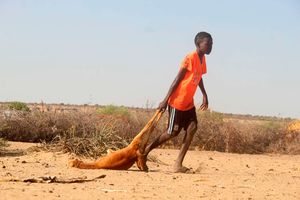Alarm bells as malnutrition killing one child every 10 seconds

A child is screened for malnutrition at Kanamkuny village,Turkana County on October 11, 2022.
What you need to know:
- Globally, 45 million children under five are affected by wasting.
- Nearly 148.1 million children under five are affected by stunting globally; with 44.4 million coming from Africa.
In every 10 seconds around the world, a child dies of malnutrition, World Vision Kenya says.
This is because of poor feeding practices at household level, lack of/or limited knowledge on diet diversity, limited access to food and lack of financial means to acquire food. In Kenya, malnutrition persists in arid counties due to multiple failed rainy seasons, inadequate child feeding practices and high disease rates.
The latest Kenya Food Security Steering Group short rains assessment report highlights that 847,932 children in the country aged six to 59 months require management of acute malnutrition.
The 2022 Kenya Demographic Health Survey report, which measured children’s nutritional status by comparing height and weight measurements against an international reference standard, found that overall ,18 per cent of children under age five are stunted or too short for their age.
Researchers explained that stunting is an indication of chronic under-nutrition. “Five per cent of children under the age five are wasted, or too thin for their height,” states the report.
Wasting is an indication of acute malnutrition, they observed, adding that 10 per cent of children under age five are underweight.
Globally, 45 million children under five are affected by wasting. According to the World Health Organization, nearly 148.1 million children under five are affected by stunting globally; with 44.4 million coming from Africa. Alice Yugi, World Vision Kenya manager, pointed out that one of the major challenges they are grappling with is feeding practices that mothers or caregivers do at the household level.
“There is lack of/or limited knowledge in terms of diet diversity compounded with other factors such as limited access to food, which affect the nutritional status of children.
“Additionally, some families do not produce enough or lack the economic capacity to access food, which leads to malnutrition,” Alice said. She added that the fight against malnutrition demands a holistic approach.
“We must review policies, promote awareness and ensure effective coordination of different sectors, ensuring accountability and access to nutritious food for all.”
Last year, World Vision Kenya’s humanitarian and disaster management teams collaborated with the Kenyan government and other partners to provide critical support to 1.3 million people affected by various emergencies with a key focus on food distribution, early warning, disaster risk reduction, and emergency response in different parts of the country.
Over 780,000 children were among those who received lifesaving assistance.
For Kenya to beat malnutrition, the regional manager, during the launch of their ‘ENOUGH’ campaign in Nairobi last week, said the country should be geared to ensuring that no child goes to bed hungry. The campaign is aimed at combating child hunger and malnutrition in Kenya. “Kenya needs to ensure improved visibility and understanding of the severity, dynamics and specifics of child hunger and nutrition at all levels,” she said. Kenya also needs to ensure more teenage girls remain in school with reduced risk of child marriage and teenage pregnancy, weakening the cycle of intergenerational child hunger and malnutrition.
“Kenya needs to ensure improved visibility and understanding of the severity, dynamics and specifics of child hunger and nutrition at all levels.”
Kenya also needs to ensure more teenage girls remain in school with reduced risk of child marriage and teenage pregnancy, weakening the cycle of intergenerational child hunger and malnutrition as well as enable children and families increase access to quality comprehensive preventive and curative nutrition services, including to address wasting.
The KDHS 2022 report highlights that for healthy growth, infants and young children should not be given sweet foods and beverages and instead should be fed healthy foods including fruits and vegetables.
“In Kenya, 49 per cent of children age six-23 months were given a sweet beverage in the day before the survey, 26 per cent had unhealthy foods, and 25 per cent consumed zero vegetables or fruit. Unhealthy feeding practices vary by breastfeeding status, with breastfed children fed fewer unhealthy foods.”





